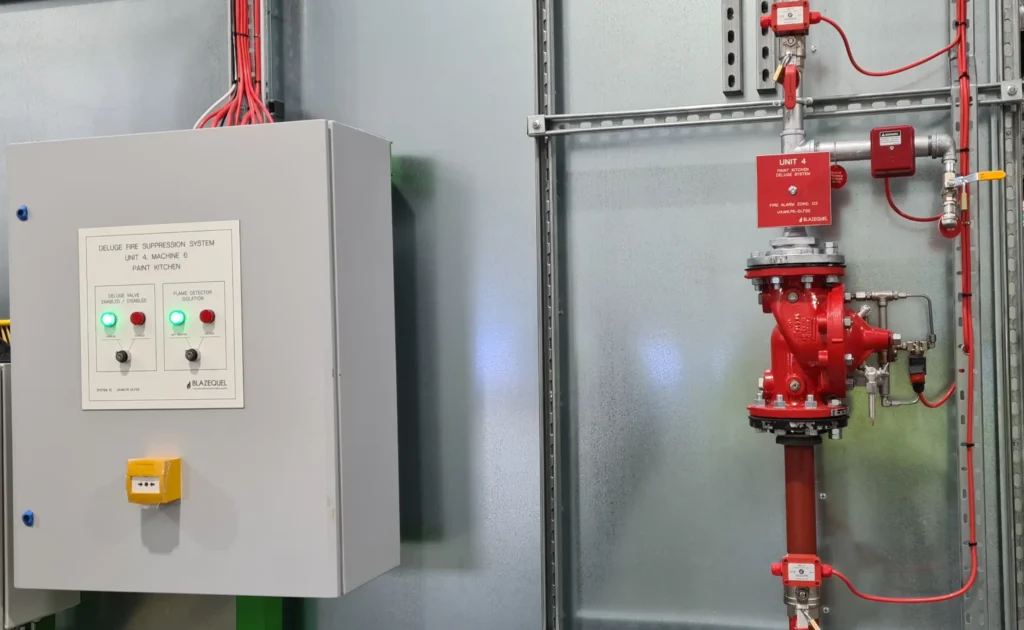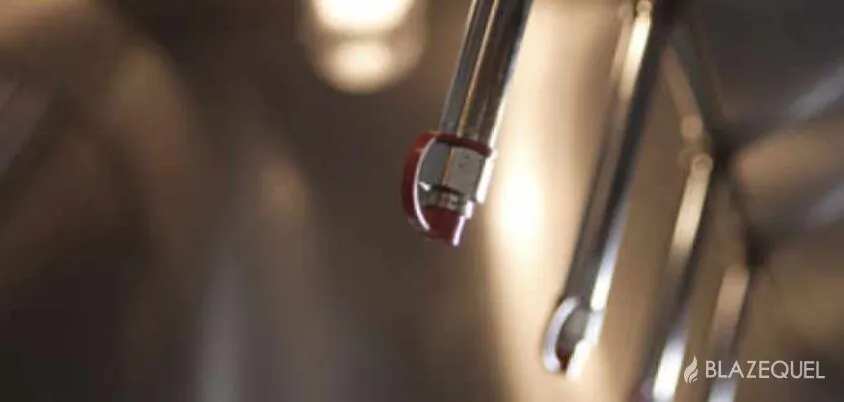
Automatic Water Cannon System
water cannons are fixed position fire extinguishing nozzles that can be used to directly target a fire at your facility.
Fire sprinkler systems are a cost-effective and reliable way to protect almost any building or asset from fire. Sprinkler systems are ideal for protecting high-hazard, industrial, and commercial applications.
Their role in asset and life protection is gaining recognition in the eyes of the authorities and insurance companies. Get in touch with us today to explore how we can safeguard your business from the threat of fire.
A fire sprinkler system is a heat activated detection and suppression system, comprising of a water supply, a network of pipes, and sprinkler heads.
Sprinkler heads are simply a water nozzle plugged by a heat sensitive element. When exposed to the heat of a fire, the element melts or bursts, releasing the water plug and allowing water to flow through the (now opened) nozzle onto the fire.
By doing so, they effectively manage or put out the fire – combining fire detection and suppression. This simplicity provides great reliability.
Unlike in the movies, sprinkler heads activate independently. If one head is activated, the water will ONLY flow from that sprinkler head. Adjoining heads would activate independently if the fire spreads – and research shows that most fires only activate 6 or less sprinkler heads!
Note: Fire sprinkler systems should be distinguished from deluge systems, which are used in especially high-hazard applications, where water is discharged from all heads simultaneously.
Fire sprinkler systems are widely used globally, with millions of sprinkler heads fitted each year.
Here’s a great example of how a sprinkler system works, in a test conducted at FM Global Research Campus.
The design and construction of sprinkler systems are essential for fire safety in industrial settings. This is especially true for places like waste, recycling, and scrap metal industries.
At recycling facilities, sprinklers play a key role in asset protection around MRF’s, under conveyors, and other equipment. They are simple, reliable, and effective for many hazard areas.
Within tipping and storage areas, sprinkler systems still have a role but are typically combined with other forms of suppression which (activated by fast acting optical detectors such as flame detection and thermal imaging), to provide early suppression in spite of the high roof and high airflow which characterize many facilities in the waste recycling sector. In these areas, sprinklers may be combined with automatic water cannons such as Fire Rover, oscillating water cannons for drenching the area, or deluge protection over specific zones.
Having a sprinkler system is beneficial for almost all properties. They are incredibly effective, preventing 99% of fires and ensuring safety. Sprinklers, along with smoke alarms, can quickly alert people and put out flames. They detect heat and use just enough water to stop the fire, saving your property from further damage.
With sprinklers, fire-related deaths can drop by 87%, showing their effectiveness. Once installed, they keep your property safe for years, especially in places where many people live or work.
Sprinklers provide peace of mind, assuring safety in case of a fire.
Everybody. However, there are some sectors and organizations that could mainly benefit from sprinkler installation. These include:
Sprinklers can make schools safer for everyone. They help prevent fires, protect students, staff, and the community. Investing in sprinklers now can save schools from being lost in a fire later.
The Department of Education agrees. They expect all new schools to have sprinklers, except for a few low-risk ones. We’re working with schools and education authorities to make sure they understand the benefits of sprinklers.
Warehouses, offices, hotels, manufacturing facilities, and retail stores can all improve safety by installing sprinkler systems. Sprinklers give people time to escape if there’s a fire and help prevent extensive damage to the buildings.
Sprinklers alone may not be sufficient in all buildings. While sprinklers are crucial for fire safety, other measures like building design, evacuation plans, and fire detection systems are also essential for comprehensive protection.
In some facilities, sprinklers provide ‘blanket’ protection for the general risk areas – whilst supplementary fire suppression systems (for example, a deluge system, water cannon or gaseous fire suppression system) would be used to protect a specific high-risk area.
Some property owners in England must install sprinkler systems to ensure safety. Here’s where it’s required:
To stay updated on these regulations, you can check the British Automatic Fire Sprinkler Association (BAFSA) website or contact us for more information.
If your business needs a sprinkler system, contact Blazequel, and we’re here to assist you. We handle everything from designing and installing standard fire sprinkler systems to repairing, upgrading, and maintaining them for your business and assets.
When it comes to cost, consulting an expert for an accurate quotation is crucial. Don’t hesitate to contact us if you want to speak with an expert and get a more precise cost estimate.
Sprinklers operate by responding to heat. Sprinkler heads come in a wide range of activation temperatures, from 57°C to 260°C – the sprinkler system designer will select a head temperature that is appropriate to the risk/area (but that should never be less than 30°C more than the operating ambient temperature of the area to help prevent false discharges).
As detailed above, when the frangible elements in the sprinkler head reaches its operating temperature it will break –, thus opening the head and allowing water to flow through the nozzle and onto the fire.
and onto the fire.
If the sprinkler system is supplied via a pump and tank system, the drop in system pressure caused by the flow of water through the activated sprinkler head will cause the pumps to start.
At the same time, flow switches on the sprinkler system will be used to activate the fire alarm for an evacuation signal and any associated notifications or actions.
Fire sprinkler systems are incredibly effective in controlling and often extinguishing fires before they can spread. Studies have shown that the chances of dying in a fire in buildings with operational sprinkler systems are reduced by 81% compared to buildings without them. Sprinkler systems also reduce property damage by 70%.
Yes, fire sprinkler systems can and often should be integrated with other fire protection systems, like fire alarms and smoke detectors. This integration can increase the overall safety and efficiency of the building’s fire defense mechanisms, providing early warning and allowing the correct follow-up actions, such as calling the fire and rescue service, shutting down your process and other measures.
Although rare, fire sprinklers can accidentally discharge due to mechanical failure or inadvertent activation, leading to significant water damage. This is a particular concern in spaces with sensitive equipment or valuable items.
In these high-operational impact scenarios (i.e., data room floors for cable protection), it is common to use an ‘interlocked pre-action system‘, whereby it requires the activation of a separate fire detection system to release water into the sprinkler pipes – plus the activation of a sprinkler head to allow that water to flow from the system. This method overcomes the risk of a false discharge.
Sprinkler systems respond to heat, which means there can be a delay between the start of a fire and the heat having built sufficiently to activate the sprinkler head(s). This delay can let the fire grow into a fast-moving fire before the sprinklers activate. However, this concern is often offset by the fact that suppression follows very swiftly after activation of a sprinkler head, so the fire growth is quickly controlled.
Ensuring a reliable and sufficient water supply can be a challenge, specifically in areas with limited water availability or pressure. This might require the installation of pumps or reservoirs, further increasing the cost.
In environments where you have a high ceiling in a storage building, there is justifiable concern by building operators that by the time a sprinkler head activates, there will be a substantial fire raging below. For example, this is a common cause for concern in waste recycling facilities.
There is good reason for this concern – a standard rule of thumb is that a fire can double in size every 30 seconds. Clearly, different hazards and fuel types will have a different fire growth rate, but irrespective the principle is the same – let the fire develop for too long and it will be raging out of control before your sprinklers intervene.
This question is too broad to provide a proper answer here, but there are a number of points that should be considered in high roofed buildings with sprinkler protection:
As a general rule, if you have a solid obstruction over 1m wide you need sprinkler protection below that point, as well as at roof level. Typical examples of this could include below conveyors or machinery. These are sometimes called ‘shielded area’ sprinklers.
This is to prevent the machinery from creating an ‘umbrella’, below which a fire can develop whilst shielded from the roof sprinkler above.
Almost invariably, the answer will be YES.
In the UK, there isn’t sufficient flow and pressure in the public water mains to effectively operate a fire sprinkler system – this means you will need to install a ‘pumped water supply’ to provide the water demands of your sprinkler system.
A sprinkler pumped water supply will require the use of a water storage tank, one or more sprinkler fire pumps, plus a ‘jockey pump’ which is used to maintain the pressure in the sprinkler system.
A sprinkler valveset is a device which controls and monitors the flow of water to the sprinkler heads on that ‘installation area’. A sprinkler system can be made up of multiple ‘installation areas’, covering different parts of the building/process.
So, in short, the valveset sits between the pumped water supply and the sprinkler head. If a sprinkler head on that ‘installation’ activates, the flow of water is detected from the valveset, allowing accurate identification of the zone area in which the sprinkler activation has occurred. The valveset includes the isolation and drainage valves which are used to reset the system after an activation.
There are different types of valveset for the different types of sprinkler system.
As detailed below, there are different types of valveset for the different types of sprinkler system.
There are three main types of fire sprinkler systems – Wet, Dry, and Pre-Action. There are also some legacy ‘Alternate’ systems still in use. These systems are
Don’t hesitate to reach out to us, or you can easily fill out the form below. We’re here to assist you.


water cannons are fixed position fire extinguishing nozzles that can be used to directly target a fire at your facility.

brilliant solution for high-risk areas, where the sometimes-slow reaction speed of sprinkler systems will allow too long for the fire

industrial kitchen fires need quick attention to prevent them spreading to ventilation ducts. An Automatic Kitchen Fire Suppression System ensures